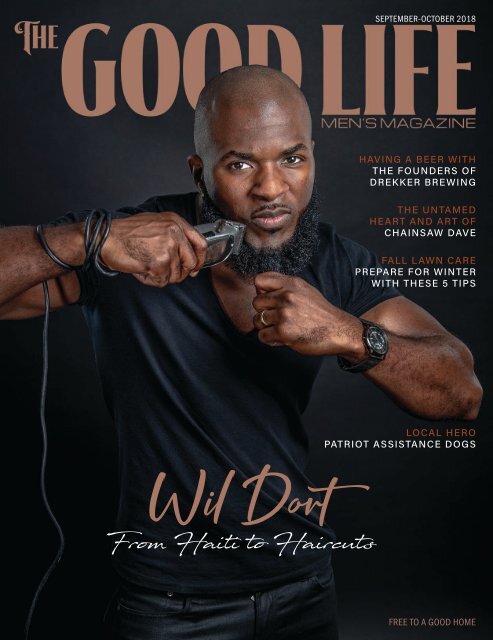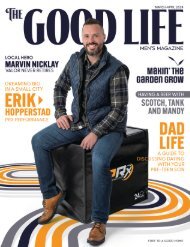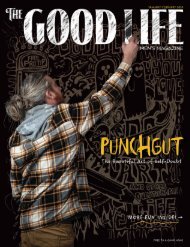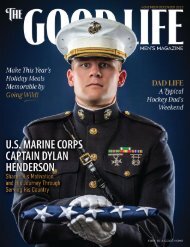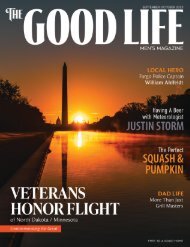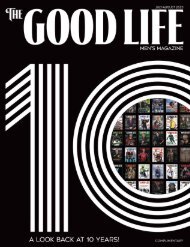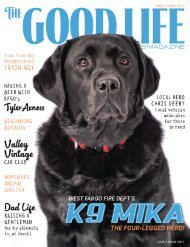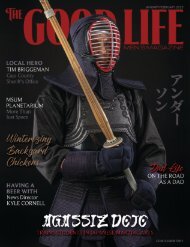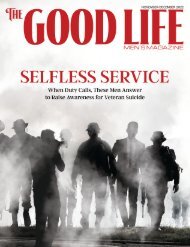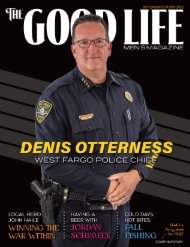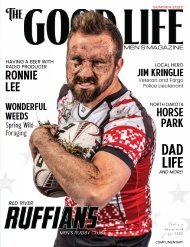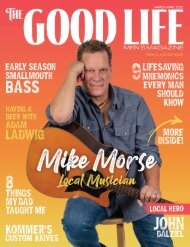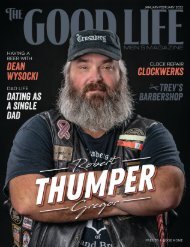The Good Life – September-October 2018
Featuring Barber Wil Dort. Local Hero - Patriot Assistance Dogs, Having a Beer with the founders of Drekker Brewing Company, Mr. Full-Time Dad and more in Fargo Moorhead's only men's magazine.
Featuring Barber Wil Dort. Local Hero - Patriot Assistance Dogs, Having a Beer with the founders of Drekker Brewing Company, Mr. Full-Time Dad and more in Fargo Moorhead's only men's magazine.
You also want an ePaper? Increase the reach of your titles
YUMPU automatically turns print PDFs into web optimized ePapers that Google loves.
SEPTEMBER-OCTOBER <strong>2018</strong><br />
HAVING A BEER WITH<br />
THE FOUNDERS OF<br />
DREKKER BREWING<br />
THE UNTAMED<br />
HEART AND ART OF<br />
CHAINSAW DAVE<br />
FALL LAWN CARE<br />
PREPARE FOR WINTER<br />
WITH THESE 5 TIPS<br />
LOCAL HERO<br />
PATRIOT ASSISTANCE DOGS<br />
Wil Dort<br />
From Haiti to Haircuts<br />
FREE TO A GOOD HOME
FATHERS | MR. FULL-TIME DAD<br />
WRITTEN BY: BEN HANSON • PHOTOS BY: URBAN TOAD MEDIA<br />
We just wrapped up a three-day party for Macklin’s third<br />
birthday. About 20 people invaded our home, ate our food<br />
and left all of their garbage behind. We had a bounce house<br />
in the backyard, beautiful weather throughout, all of Mack’s<br />
favorite people… even the Blue Angels came to town to<br />
celebrate. It was a wild success.<br />
As expected, Mack raked in a pile of awesome gifts sure<br />
to hold his attention until the end of this sentence — fresh<br />
cans of Play-Doh, new bubbles, his first pair of rollerblades,<br />
some water toys, the obligatory new outfit from Grandma<br />
and a pedal-powered go-kart complete with roll cage and<br />
emergency brake. As I watched him climb in and take off<br />
down the sidewalk, I couldn’t help but envy him.<br />
If it wasn’t Mack’s birthday weekend, I would struggle to<br />
answer the Monday morning question “What’d you do this<br />
weekend?” So, asking me what I was doing when I was 3<br />
years old would be like asking my current 3-year-old to fix<br />
my currently broken water softener. Try as we might, it just<br />
isn’t going to happen.<br />
What I can confidently say is I wasn’t driving around in my<br />
own go-kart at 3. I also don’t recall ever having my own<br />
private backyard carnival with the Blue Angels screaming<br />
overhead. No, I remember birthdays at McDonald’s (which<br />
was awesome… I still have my special birthday McDonald’s<br />
mug) and dreaming about go-karts.<br />
Pondering my son’s charmed life as I snuck an extra-large<br />
piece of cake while safely out of view, a thought bubbled<br />
up in my mind… 3 is the new 23. At 23, I was just about<br />
a year into my first full-time job after graduating from<br />
college, which meant I finally had the means to indulge my<br />
own childhood fantasies. I didn’t buy myself a go-kart, but I<br />
definitely walked out of Best Buy with a new 42-inch plasma<br />
screen and signed up for the HD package with DVR as soon<br />
as that first paycheck cleared.<br />
My son has never known life in standard def. He drives a gokart<br />
to the park. His favorite toy is also my favorite toy — an<br />
$800 iPad. You see, 3 is the new 23. After finishing my cake,<br />
I came up with a few more examples…<br />
Baby Foodie<br />
Had it not been for my cousin, who now takes me elk<br />
hunting against his better judgement, the only red meat I<br />
would have known growing up would’ve been beef. Macklin,<br />
2 / THE GOOD LIFE / urbantoadmedia.com<br />
on the other hand, has been developing a discerning palette<br />
since the day his first teeth started coming in. He already<br />
knows what venison tastes like, along with elk, shrimp,<br />
salmon, walleye, crab, scallops, antelope, pheasant, etc. I<br />
was in my mid-20s before I even knew what a scallop was,<br />
let alone how gross they are.<br />
Junior Outdoorsman<br />
Mack was barely two months old when he experienced<br />
his first legitimate road trip (and still hadn’t celebrated a<br />
birthday before he spent his first night sleeping in a tent).<br />
Now, by age 3, he’s an accomplished camper who loves to<br />
fish, hike, swim in the lake and touch everything he can<br />
reach without hint of fear. Come winter, it’ll be season two<br />
of riding his very own snowmobile across the frozen lake<br />
at Grandma and Grandpa’s. Before the end of this summer,<br />
we’re heading to the mountains of Colorado to not only see<br />
the Rockies, but also to bring Mack to his first live concert…<br />
yep, at Red Rocks. What a time to be a 3-year-old.<br />
Fitness Bro<br />
Mack’s latest favorite breakfast is a children’s protein<br />
shake. It’s true. <strong>The</strong> body shaming starts early nowadays.<br />
Reading the ingredients, his shake is not that different<br />
than the ones I occasionally mix up after the gym. He’s not<br />
working on bulking up or optimizing his metabolism. He<br />
just likes doing whatever I do... and I’m guessing he likes<br />
the chocolate flavor and the fact that he gets to drink a<br />
“shake” for breakfast. After a rousing hour of Jazzercise in<br />
the basement on Saturday mornings, my mom would mix<br />
up a shake of some sort, but I don’t remember ever getting<br />
a taste. Mack has his own Blender Bottle.<br />
Style<br />
If I were to die tomorrow, whoever gets stuck writing my<br />
eulogy won’t be reminiscing about my great wardrobe and<br />
natural style. Mack, on the other hand, rocks a hot pink<br />
speedo like some sort of tiny French fashionista confidently<br />
strutting down the Riviera. When he was 2, he had flowing<br />
curls long enough to put into a ponytail. He had a man<br />
bun before he was potty trained. Honestly, I think he<br />
currently owns more pairs of shoes than I do.<br />
Sure, Mack has things like global warming, that new<br />
tax form and the potential of living through WWIII to<br />
worry about, too, but it’s hard not to be envious of the<br />
opportunities provided to him... as well as his natural<br />
instincts that must come from his mother’s side. •
urbantoadmedia.com / THE GOOD LIFE / 3
Contents<br />
SEPTEMBER-OCTOBER <strong>2018</strong><br />
VOLUME 6 • ISSUE 2<br />
2<br />
FATHERS / MR. FULL-TIME DAD<br />
3 IS THE NEW 23<br />
6<br />
FARGO-MOORHEAD TRAILBUILDERS<br />
GETTING BACK INTO NATURE<br />
10<br />
HAVING A BEER WITH<br />
THE FOUNDERS OF DREKKER<br />
BREWING COMPANY<br />
14<br />
UNITING THE COMMUNITY<br />
VETERAN, MUSICIAN, ADVOCATE: TOM HILL<br />
18<br />
ON THE COVER: WIL DORT<br />
FROM HAITI TO HAIRCUTS<br />
EX-CON TURNS LIFE AROUND TO OPEN<br />
SKILL CUTZ BARBERSHOP<br />
24<br />
THE UNTAMED HEART AND ART OF<br />
CHAINSAW DAVE<br />
28<br />
FALL LAWN CARE<br />
PREPARE FOR WINTER WITH THESE<br />
5 FALL LAWN CARE TIPS<br />
30<br />
LOCAL HERO<br />
PATRIOT ASSISTANCE DOGS<br />
OFFERS HOPE AND HELP FOR DOGS<br />
AND VETS<br />
4 / THE GOOD LIFE / urbantoadmedia.com
PUBLISHED BY<br />
Urban Toad Media LLP<br />
www.urbantoadmedia.com<br />
OWNER / PHOTOGRAPHER<br />
Darren Losee<br />
darren@urbantoadmedia.com<br />
OWNER / GRAPHIC DESIGNER<br />
Dawn Siewert<br />
dawn@urbantoadmedia.com<br />
CONTRIBUTING WRITERS<br />
Meghan Feir<br />
Alexandra Floersch<br />
Brittney <strong>Good</strong>man<br />
Ben Hanson<br />
Katie Jenison<br />
Krissy Ness<br />
Danielle Teigen<br />
CONTRIBUTING PHOTOGRAPHER<br />
MJoy Photography<br />
ADVERTISING INQUIRIES<br />
Beth Reich / beth@urbantoadmedia.com<br />
READ A PAST ISSUE<br />
issuu.com/thegoodlifemensmag<br />
FOLLOW US ON FACEBOOK<br />
facebook.com/urbantoadmedia<br />
FOLLOW US TWITTER<br />
@urbantoadmedia<br />
<strong>The</strong> <strong>Good</strong> <strong>Life</strong> Men’s Magazine is distributed six times<br />
a year by Urban Toad Media LLP. Material may not be<br />
reproduced without permission. <strong>The</strong> <strong>Good</strong> <strong>Life</strong> Men’s<br />
Magazine accepts no liability for reader dissatisfaction<br />
arising from content in this publication. <strong>The</strong> opinions<br />
expressed, or advice given, are the views of individual<br />
writers or advertisers and do not necessarily represent<br />
the views or policies of <strong>The</strong> <strong>Good</strong> <strong>Life</strong> Men’s Magazine.<br />
urbantoadmedia.com / THE GOOD LIFE / 5
6 / THE GOOD LIFE / urbantoadmedia.com
When riding<br />
these paths you can<br />
see the enjoyment on<br />
people's faces,<br />
and it is definitely<br />
a workout.<br />
WRITTEN BY: KRISSY NESS<br />
PHOTOS BY: MJOY PHOTOGRAPHY<br />
Since late 2009 members of the Fargo-<br />
Moorhead Trailbuilders have been<br />
successfully creating and maintaining<br />
mountain bike trails in the FM area. It became<br />
a nonprofit in early 2014 and is made up of<br />
avid bikers who volunteer their time to ensure<br />
safe and accessible trails. “<strong>The</strong>re’s probably<br />
close to 10 people who are really active with the<br />
organization and at least another dozen to two<br />
dozen helping out and pitching in,” said Tom<br />
Heilman, Vice President of FM Trailbuilders.<br />
After graduating college at NDSU and moving<br />
to Denver for his first job, Heilman picked up<br />
mountain biking and fell in love with it. After<br />
some time he moved back to Fargo and quickly<br />
realized there wasn’t a lot of access to riding.<br />
“Through meeting some people in the community...<br />
we started coming up with some random ideas<br />
and one of the first spots was in North Moorhead,<br />
MB Johnson Park,” said Heilman. “It was a pretty<br />
rough trail and we went through and wacked some<br />
weeds and created a real hodgepodge trail, it was<br />
pretty self-serving and it just gave four or five of us<br />
access to go ride in a loop.”<br />
After they found some success with this trail, it was<br />
decided that they should clear it with the city to be<br />
on the up and up and also with the community. “It<br />
was a growing sport. It still is. It is something people<br />
want to have access to,” said Heilman. “So, we got<br />
a little more serious formed a little organization and<br />
came up with a name, Fargo-Moorhead Trailbuilders,<br />
and came up with a logo through a friend who did<br />
some of that stuff. <strong>The</strong>n met with the director of park<br />
and recreation of Moorhead at the time and they were<br />
right on board with us from the get-go. <strong>The</strong>y have been<br />
outstanding to work with.”<br />
Since building a trail in MB Johnson they have added<br />
trails in Gooseberry Park and Horn Park in Moorhead,<br />
and on the Fargo side, there are formal trails at Iwen<br />
Park, totaling over 11 miles.<br />
urbantoadmedia.com / THE GOOD LIFE / 7
It is just<br />
a great way to get out<br />
into nature and get<br />
some exercise at a<br />
faster pace than<br />
hiking or jogging.<br />
If you hop over to their website, www.<br />
fmtrailbuilders.org, you will be able to do a<br />
multitude of things, from checking the trail<br />
conditions to donating money or time to help<br />
maintain the trails. <strong>The</strong>y partner with Trailforks<br />
to give a detailed layout of every trail and the<br />
condition it is in on any given day. It also shows<br />
experience levels of each trail, which can be<br />
helpful, especially on days when the kids are with.<br />
<strong>The</strong>re is no age limit when it comes to riding these<br />
trails, but please remember to travel at your own<br />
speed and experience level. Also, making sure your<br />
bike is in working order and always wear a helmet.<br />
When biking on these trails pay attention to the<br />
markers so you are aware of what direction you<br />
should be traveling, most of these trails are designed<br />
to be ridden counter-clockwise.<br />
<strong>The</strong>se trails are also seasonal, as long as you have<br />
the proper tires <strong>–</strong> Fat Tires, which are four to fiveinch<br />
tires made especially for winter biking. Through<br />
generous donation and donated times there is also a<br />
groomer that goes out and packs the trails down in the<br />
winter so these trails can be used all year.<br />
Along with casual mountain biking, these trails also<br />
host events and races, though they are not directly<br />
connected to the FM Trailbuilders. This year 13 high<br />
school students have signed up to participate in a<br />
league, which is a great addition to activities that are<br />
being held in Fargo-Moorhead.<br />
“FM Trailbuilders isn’t about racing, it is about building<br />
and developing trails, the racing and events are just<br />
things to get people out to have fun and celebrate the<br />
fact that we have some trails,” said Heilman. “It’s grown<br />
tremendously, we’ve got the right people in place; the<br />
right volunteers. This last three years it has been really<br />
impressive to see the number of people who have reached<br />
8 / THE GOOD LIFE / urbantoadmedia.com
out, not only to help, but the faces we are seeing out on the<br />
trails are almost always new.”<br />
When riding these paths you can see the enjoyment<br />
on people’s faces, and it is definitely a workout. I would<br />
recommend this to any and all of my friends who are active<br />
in the community, it is just a great way to get out into<br />
nature and get some exercise at a faster pace than hiking<br />
or jogging.<br />
“When this was all just beginning and it was a group of<br />
three or four guys and some sticks and a shovel, it was all<br />
people we knew, and now it is to the point where when I<br />
go out onto a trail it’s the other way around,” said Heilman.<br />
How exciting it is to see something start so small and<br />
develop into a sport that so many people in Fargo were<br />
clearly looking for.<br />
“<strong>The</strong> organization’s volunteers, board, and user base come<br />
from all types of backgrounds. Financial, legal, medical,<br />
engineering, construction, you name it. I think we have it<br />
represented, which is also a great indication that it’s not<br />
an exclusive activity. In fact, I think it’s probably the most<br />
open group of people in any sport I’ve ever been associated<br />
with,” said Heilman.<br />
Everyone involved with FM Trailbuilders is a volunteer;<br />
no one is being paid, which shows the dedication to this<br />
sport and organization. If you enjoy the trails or want to<br />
donate your time to help maintain the trails hop over to<br />
their Facebook page or website and get signed up, every<br />
little bit helps.<br />
“It is an activity people can do their whole life and it can<br />
be just for fun, it doesn’t have to be racing,” said Heilman. •<br />
urbantoadmedia.com / THE GOOD LIFE / 9
HAVING A BEER WITH | DREKKER BREWING<br />
WRITTEN BY: MEGHAN FEIR • PHOTOS BY: URBAN TOAD MEDIA<br />
HAVING A BEER WITH THE FOUNDERS OF<br />
DREKKER<br />
BREWING COMPANY<br />
What goes into a bottle (or a can)<br />
of beer? For the founding fathers of<br />
Drekker Brewing Company, all the<br />
risks and hard work has been worth<br />
it when they see the community they<br />
love come together over a brew.<br />
<strong>The</strong>se lifelong friends — Mark<br />
Bjornstad, Jesse Feigum, Mason<br />
Montplaisir and Darin Montplaisir —<br />
eventually shared the same affinity<br />
for beer making. After brewing out<br />
of Bjornstad’s garage for a few years,<br />
their hobby soon transformed into<br />
something greater. Friends of friends<br />
became fans of their craft, and their<br />
desire to start a business grew along<br />
with their following.<br />
Since <strong>October</strong> of 2014, Drekker has<br />
had a presence in downtown Fargo,<br />
but for our interview, we sat in the<br />
bones of their latest endeavor: a<br />
beautiful monstrosity of a building<br />
just off 1st Avenue in Fargo that<br />
hasn’t been occupied since the ‘60s.<br />
We talked about the friends’ history<br />
and even dug up some tidbits they<br />
didn’t know about each other, a feat<br />
none of them thought was possible.<br />
Read on to discover more about some<br />
of Fargo’s most beloved hometown<br />
brewers.<br />
DREKKER = a combination of Old Norse words:<br />
drekka - to drink / drykkr - a draft drink / drakkar - a Viking dragon ship<br />
10 / THE GOOD LIFE / urbantoadmedia.com
MARK BJORNSTAD<br />
Hometown: Fargo<br />
Day job: Anesthetist at Sanford<br />
Position at Drekker: Captain of the Drekker Ship and Scientist<br />
Behind the Beer<br />
<strong>Good</strong> <strong>Life</strong>: Why Drekker? Where does the name come from?<br />
Mark Bjornstad: We love this area, the Norse culture and<br />
Scandinavian heritage, so we wanted something that would echo<br />
that and tie into the fabric of this community, like the Hjemkomst<br />
ship. It’s a drakkar — a Viking dragon ship. It’s what they took<br />
into battle. A year after we opened we had a group come in from<br />
Iceland and they loved the brewery. <strong>The</strong>y kept saying how cool the<br />
name was, and we were like, “Yeah, it’s the Viking ship and means<br />
‘to drink.’” <strong>The</strong>y were like, “No, it’s the Icelandic slang term to go<br />
out and share a pint and go out with your friends.” That’s really<br />
kind of kismet because we say our mission is that beer is our<br />
craft, but Drekker is a lot more than the contents of the glass. It’s<br />
about those glasses getting raised together.<br />
GL: What is something even your Drekker family doesn’t know<br />
about you?<br />
MB: One summer, when I was a kid, I made bolo ties and sold<br />
them.<br />
GL: That was so much better of an answer than what I was<br />
expecting.<br />
MB: My grandpa bought one.<br />
GL: If you ever start that as a side business again, I will buy one<br />
for my boyfriend.<br />
JESSE FEIGUM<br />
Hometown: Barnesville<br />
Position at Drekker: Head of Nerdery (manages anything that<br />
beeps and boops), Logo Enlargement Specialist<br />
GL: How did you know you wanted to start Drekker and what was<br />
the process like?<br />
JF: We kind of all got into brewing and became obsessed with that<br />
around the same time. It just seemed like the natural progression<br />
of things. We felt like if we didn’t do this, we’d kick ourselves for<br />
the rest of our lives.<br />
GL: What is the secret to having a good beard?<br />
JF: Don’t shave, no matter what others tell you.<br />
GL: How about being a man?<br />
JF: It helps, but it’s not entirely necessary. Don’t shave. Use<br />
conditioner — lots of it.<br />
GL: Does the humidity affect it?<br />
JF: Probably. Having a wife that likes it helps a lot. If you spend<br />
too much time worrying about your beard you’re going to overdo<br />
it. And go to a barber and get it trimmed every once in awhile.<br />
GL: What is one thing your Drekker family doesn’t even know<br />
about you?<br />
JF: I did not make bolo ties. When I was in second grade I wanted<br />
to start a business making rubber band guns. I made like 50 of<br />
them. <strong>The</strong>y probably got thrown away. It was a short phase, but<br />
for about a week there, my plan to take over the world involved<br />
rubber band guns.<br />
urbantoadmedia.com / THE GOOD LIFE / 11
HAVING A BEER WITH | DREKKER BREWING<br />
DARIN MONTPLAISIR<br />
Hometown: Moorhead<br />
Position at Drekker: Head Brewer, Yeast Wrangler and Master of<br />
Janitorial Arts<br />
Cousin: Mason<br />
GL: What’s the best combination of food and beer?<br />
DM: A perfectly done steak with an IPA — but then again, the<br />
child in the back of my head is thinking of a chocolate ice cream<br />
paired with a stout at the end. That’s really all I’m looking for. Any<br />
of our chocolate-flavored beers paired with a dessert is the finale<br />
at the end and my favorite.<br />
GL: What is your favorite kind of beer, though.<br />
DM: Stop it.<br />
GL: Sorry.<br />
DM: I think the darker, wintrier beers. <strong>The</strong>y can go in so many<br />
directions. <strong>The</strong>y can be really thick, they can be big and chocolaty,<br />
and you can take the same beer and barrel age it and it turns into<br />
something completely different. I think I like those the best, the<br />
dessert-style beers.<br />
GL: Was it freaky to break away from your old job and start this<br />
new venture?<br />
DM: It still is. Every day is a wonderful combination of excitement<br />
and tons of fear. It’s this confused feeling. I walked away from<br />
something I was very confident in and good at into something<br />
I had to figure out on the fly. Every time we feel like we’re just<br />
getting comfortable, something else happens, like building this<br />
place. I have not felt comfortable for even a second, but I think<br />
that’s a good thing.<br />
MASON MONTPLAISIR<br />
Hometown: Moorhead<br />
Position at Drekker: Schmengineer, Chief of Hipster Relations<br />
Cousin: Darin<br />
GL: What’s a schmengineer?<br />
MM: I graduated with an engineering degree and I was an<br />
engineer before this. Now I’m just a schmengineer. Jesse kept<br />
making it as a password for me and I could never spell it.<br />
GL: Why do you like beer so much?<br />
MM: It’s so versatile. You can do so many different things and<br />
reach so many people with beer. You can find a beer for anybody.<br />
<strong>The</strong>re are thousands of recipes, and you can add anything you<br />
can think of to beer. <strong>The</strong>re will never be one beer that’s the same.<br />
12 / THE GOOD LIFE / urbantoadmedia.com<br />
GL: Do you have any unusual hobbies, like making beer-scented<br />
candles?<br />
MM: We don’t have time for hobbies. I used to juggle really well. I<br />
honestly like to dance.<br />
GL: What kind of dancing?<br />
MM: Swing dance. Schwing dance. Schmengineering schwing<br />
dance.<br />
GL: Other than schwing dancing, what other dances do you like?<br />
MM: Is the worm a dance because I like to do the worm.<br />
GL: It is. Any schalsa?<br />
MM: <strong>The</strong> schwaltz.
What does living<br />
the good life<br />
mean to you?<br />
• • •<br />
It’s going out and<br />
being able to share<br />
your crafts and being<br />
proud of what you do.<br />
<strong>The</strong> best part of this for<br />
me is sharing what I<br />
love to do with people.<br />
<strong>–</strong> Mason Montplaisir<br />
urbantoadmedia.com / THE GOOD LIFE / 13
UNITING THE COMMUNITY<br />
Veteran, Musician, Advocate: Tom Hill<br />
WRITTEN BY: BRITTNEY GOODMAN<br />
PHOTOS BY: URBAN TOAD MEDIA<br />
Tom Hill, Director of Community Impact for United Way<br />
of Cass-Clay (UWCC) is a military veteran and musician<br />
who is living his calling of helping others and improving<br />
our community.<br />
Hill grew up in Bismarck, where his parents still reside in<br />
his childhood home.<br />
After high school, in 2000, Hill joined the Army, with<br />
basic training at Fort Leonard Wood in Missouri: “I joined<br />
the Army because I wanted to be a part of something<br />
bigger than me. I wanted adventure, travel and to have<br />
experiences I would otherwise not be able to have. I also<br />
liked the idea of duty and service.”<br />
Hill served as a combat engineer and his first duty<br />
station was at Camp Howze, a couple of miles south<br />
of the demilitarized zone in South Korea.<br />
Hill joined the North Dakota National Guard<br />
in early 2003. As part of a humanitarian<br />
peacekeeping mission in Bosnia from July<br />
2003 <strong>–</strong> April 2004, he monitored the clearing<br />
of minefields to ensure the application of<br />
humanitarian standards so that the cleared<br />
areas would be safe for civilian use.<br />
“One of the coolest experiences in my life<br />
was with the Bosnian minefields. This<br />
minefield was as large as a football field,<br />
taped off into lanes. <strong>The</strong> people clearing<br />
it used a yardstick and went centimeter<br />
by centimeter to test for mines. We<br />
stood with them. After one minefield<br />
was cleared, I witnessed a farmer<br />
bringing his sheep onto the cleared,<br />
former minefield. Something that<br />
was created in hate and anger and<br />
now, a decade later, it is a farm. It<br />
was like the minefield was never<br />
there. <strong>The</strong> farmer had an occupation<br />
again.” He added, “Being able to see<br />
that and know I was a part of doing<br />
something good gave me a sense<br />
of pride.”<br />
14 / THE GOOD LIFE / urbantoadmedia.com
"Volunteering,<br />
studying abroad and<br />
the military gave me<br />
an understanding<br />
of the differences in<br />
people, and what<br />
unites us. Being able to<br />
make a difference and<br />
form partnerships is<br />
important.”<br />
<strong>–</strong> Tom Hill<br />
urbantoadmedia.com / THE GOOD LIFE / 15
"Our community is not too<br />
big, not too small. It is the<br />
right size. It is becoming more<br />
and more of a progressive<br />
community. I like seeing that<br />
and being a part of that."<br />
<strong>–</strong> Tom Hill<br />
After the military, Hill attended<br />
Minnesota State University Moorhead<br />
(MSUM) on the GI Bill, earning his<br />
bachelor’s in Communication Studies<br />
and Spanish in 2008. While at MSUM,<br />
he studied abroad in Mexico: “I love<br />
Latin American history and Pre-<br />
Columbian civilization. Mayan and<br />
Aztec history and their astronomy,<br />
engineering, and architecture<br />
fascinates me.”<br />
Post-graduation, Hill volunteered for<br />
a study abroad 4-month experience to<br />
Peru. He taught English to children<br />
from 5 to 17 years of age. <strong>The</strong> poverty<br />
he witnessed touched and galvanized<br />
him to do more than teach English.<br />
<strong>The</strong> lesson plan “went out the<br />
window” and Hill focused on being<br />
a caring and positive influence. <strong>The</strong>y<br />
played soccer, went to the zoo and<br />
made and ate food together.<br />
After Peru, he knew he wanted to work<br />
to help people. His new position at<br />
United Way of Cass-Clay in 2008 was<br />
a perfect fit. Starting out managing<br />
the School Supply Drive and Day of<br />
16 / THE GOOD LIFE / urbantoadmedia.com<br />
Caring for senior citizens, Hill worked<br />
his way to the Director of Community<br />
Impact where he now manages<br />
external investment strategies: “the<br />
process of strategically investing<br />
the money we raise back in the<br />
community.”<br />
<strong>Life</strong> experience prepared him to be<br />
effective in his work: “Volunteering,<br />
studying abroad and the military<br />
gave me an understanding of the<br />
differences in people, and what unites<br />
us. Being able to make a difference<br />
and form partnerships is important.”<br />
At UWCC, Hill said, “we work to<br />
understand the greatest needs in our<br />
community. We examine local data<br />
and national trends in areas of need<br />
such as child care, homelessness,<br />
workforce development, mental<br />
health. etc. How do these trends apply<br />
here? <strong>The</strong>n we mobilize individuals <strong>–</strong><br />
we get the right people at the table <strong>–</strong><br />
to form a strategy to reach a solution<br />
to the problem. <strong>The</strong>n we measure to<br />
see if what we are doing is working,<br />
and invest resources to do more.”<br />
Improving early childhood education<br />
is one passion: “<strong>The</strong>re is a ton of<br />
research about the importance of<br />
early childhood education and quality<br />
child care. When someone thinks<br />
investing in children now won’t show<br />
an impact for twenty years, they are<br />
wrong. It makes a difference. Children<br />
from third grade on need to read<br />
in order to learn. What we invest in<br />
early childhood will make them better<br />
prepared socially, emotionally and<br />
academically. Studies show young<br />
children who receive quality education<br />
and child care are less involved with<br />
juvenile justice and incarcerations.<br />
Child care is a fundamental thing that<br />
we all should care about.”<br />
Hill used this metaphor for bettering<br />
young children: “When is the best time<br />
to plant a tree? 15 years ago. We need<br />
to plant the trees now.”<br />
Hill is devoted to his wife Linny; their<br />
four-month-old son, Shepherd; and<br />
their dog, cats, chickens and soon,<br />
ducks. He loves Fargo-Moorhead:<br />
“Our community is not too big, not too
small. It is the right size. It is becoming more and<br />
more of a progressive community. I like seeing that<br />
and being a part of that.”<br />
Hill also enjoys playing drums in the band, Go<br />
Murphy: “Some people play golf, I play in a band,”<br />
finding it “an honest way of conveying emotions.”<br />
“<strong>The</strong> good life” means this to Hill: “It is my wife, my<br />
son, my pets, my band and my work. I love what I do<br />
and where I am at. I sometimes think I don’t deserve<br />
what I have. It is staying grounded <strong>–</strong> realizing what<br />
I have, being humble and using my talents to help<br />
others. I’m a lucky person with a lot of great people<br />
in my life. I’ve had love and support and if I can give<br />
some of that back, great.” •<br />
urbantoadmedia.com / THE GOOD LIFE / 17
ON THE COVER | WIL DORT<br />
18 / THE GOOD LIFE / urbantoadmedia.com
Wil Dort<br />
From Haiti to Haircuts<br />
WRITTEN BY: ALEXANDRA FLOERSCH<br />
PHOTOS BY: URBAN TOAD MEDIA<br />
It’s the story of a childhood right out of a TV commercial,<br />
pleading “Feed the children,” “Donate just 63 cents a day”<br />
or “You can shine bright in the toughest places to be a child.”<br />
No electricity. A hilly, exhausting walk to school. And each<br />
day came without a guarantee of his next meal.<br />
Wil Dort, 33, was born into this life in Haiti.<br />
Now the co-owner of Skill Cutz in Fargo, Dort recalls<br />
his early years without the amenities of modern,<br />
American living. He and his siblings grew up living<br />
with his grandma in the countryside, because his<br />
mother moved to the city to start a business in<br />
hopes of supporting the family.<br />
“My life, it was very different than what you see<br />
here,” Dort recalled.<br />
At just 4 or 5 years old, he would wake up at 6<br />
a.m. to check on and feed the chickens, cows and<br />
pigs and make himself a little breakfast <strong>–</strong> whatever<br />
he could find <strong>–</strong> all before going to school.<br />
“If you’re blessed enough where they serve lunch that<br />
day, you’ll get a lunch,” he explained. “(Lunch) wasn’t<br />
every day. It could be breakfast to dinner. You’d be blessed<br />
to get a snack in between.”<br />
Typically, the schools were funded through missionaries,<br />
but now and then the pantry would get robbed.<br />
“Times get hard and people look for a way out,” Dort said.<br />
“We got a small allowance <strong>–</strong> maybe 50 cents or $1 for the<br />
week at the most. I could never budget so I’d use that to eat<br />
Monday and Tuesday, then it was gone.”<br />
Living a 45-minute walk away from the closest river, just<br />
getting drinking water came with its challenges.<br />
“<strong>The</strong> same place the animals were drinking <strong>–</strong> that’s where<br />
we had to drink, too,” Dort said. His trek to school looked<br />
similar <strong>–</strong> two hours each way.<br />
“It wasn’t flat. You have to cross like two rivers and climb<br />
a mountain. It was quite the journey,” he recalled, able to<br />
chuckle about it now. “We were considered better off and<br />
more fortunate than most. As a kid, you’d never experienced<br />
anything different. That was the norm.”<br />
A Step Below Heaven<br />
Early on, Dort recognized the common goal shared by all<br />
Haitians.<br />
“<strong>The</strong>re’s 10 million people over there and everyone’s hoping<br />
and dreaming to make it to America. Heaven is here,” he<br />
said, setting the bar with his hand. “And America is here <strong>–</strong><br />
right below heaven.”<br />
For Dort and his family, that dream would eventually<br />
become a reality.<br />
His father made the trek in 1994. He couldn’t read or write,<br />
but he learned how to sign his name on the way to America.<br />
Working for $5 to $6 an hour at Federal Beef in Fargo, little<br />
by little he’d send money home.<br />
“Unfortunately, he got us here on November 5, 1997 and<br />
then he passed away the fall of 2000,” Dort said. “That<br />
really took a toll on all of us. If he didn’t make the sacrifice,<br />
we would have never made it here.”<br />
Ex-Con Turns <strong>Life</strong> Around<br />
to Open Skill Cutz Barbershop<br />
urbantoadmedia.com / THE GOOD LIFE / 19
ON THE COVER | WIL DORT<br />
"<strong>The</strong> home i grew up in.<br />
Family of six - makes me<br />
realize how blessed i am<br />
today." - Wil Dort<br />
PHOTO SUBMITTED BY: WIL DORT<br />
Finding His Wings<br />
After his father died, Dort began testing his boundaries. He<br />
attended Fargo North but flunked his senior year.<br />
“I was rebelling against my mom who was trying to raise<br />
me as a man,” he said. “<strong>The</strong> things she was saying <strong>–</strong> I know<br />
now were good for me <strong>–</strong> I didn’t follow.”<br />
At 18, he moved out and was introduced to temptations he<br />
couldn’t resist. What started with marijuana and alcohol<br />
eventually escalated.<br />
“It was a crazy, out-of-control spin in my life <strong>–</strong> just using,<br />
abusing and selling drugs,” he said. “It wasn’t long after that<br />
I found myself on the streets. I was evicted and didn’t have<br />
a place to sleep.”<br />
From 2004 to the winter of 2005, Dort lived on his buddy’s<br />
trailer floor until an informant eventually busted him for<br />
selling methamphetamine. In the middle of the chaos,<br />
something told him to go to New York where his stepbrother<br />
lived. He shoved his clothes into a black, plastic bag,<br />
left his apartment and car to a buddy and told his girlfriend<br />
he was moving.<br />
After successfully quitting drugs cold<br />
turkey in New York, Dort bounced<br />
back to his old ways when he<br />
returned to North Dakota in 2006.<br />
With the chill of winter came a<br />
shocking phone call from his<br />
brother, asking "What are you<br />
doing in Fargo's Most Wanted?”<br />
PHOTO SUBMITTED BY: WIL DORT<br />
WIL AND HIS WIFE MBANG<br />
20 / THE GOOD LIFE / urbantoadmedia.com
As it turns out, two years prior his roommate had<br />
taken his sister’s car, gotten drunk, crashed<br />
it and left the scene of the crime. Law<br />
enforcement traced it back to Dort’s<br />
mother’s house and caught his<br />
friend red-handed. Because of<br />
his previous record, the friend<br />
gave Dort’s name as his own.<br />
For whatever reason, Dort allowed it,<br />
paid the fees, performed community service and went to<br />
alcohol evaluation. Just when he thought he had paid his<br />
(friend’s) dues, he was pulled over on his 20th birthday and<br />
arrested on a warrant for a hit and run <strong>–</strong> dating back to the<br />
original incident.<br />
"I spent three to four days in jail,” Dort said. “Where was<br />
the friend who was supposed to bail me out? Nowhere to<br />
be found.”<br />
Thankfully, his girlfriend at the time, Mb (short for Mbang),<br />
came to the rescue. His future bride knew he was struggling<br />
and living on the street, but she never knew the full extent<br />
of his story.<br />
“I ended up telling her everything. I feel like God was<br />
preparing me by clearing the air of everything I did," he said.<br />
"I think it helped me keep her. Because she didn't know the<br />
person that was about to come out.”<br />
Pedaling Toward Success<br />
Even in Haiti, Dort started cutting hair at just 8 or 9 years<br />
old, so when he was looking for change, Mb helped him<br />
take the next step.<br />
"Man, she's an angel,” he said. “She got me into barber<br />
school.”<br />
Throughout school, he was still attending court for his<br />
charges. One day, he left school and didn’t return.<br />
Unbenounced to him, Dort’s lawyer showed up late to court<br />
to inform him of the plea deal he had accepted without<br />
Dort’s knowledge on his behalf. He was sentenced to nine<br />
months in jail and was booked that day.<br />
Worse yet? As a convicted felon, his financial aid would be<br />
cut off.<br />
urbantoadmedia.com / THE GOOD LIFE / 21
ON THE COVER | WIL DORT<br />
Thankfully, during his sentence, Dort was introduced to a program called the Jail<br />
Chaplains Association. In Haiti, his dad was a voodoo priest and Dort attended church<br />
stubbornly in Fargo as a kid, but never really found his faith.<br />
"I knew I wanted to change. I felt like (Mb) was an angel and I was a demon,” he said.<br />
"I believe God put us together. <strong>The</strong> things that I put her through <strong>–</strong> to stick with me <strong>–</strong> I<br />
believe only in Christ you find that kind of love.”<br />
By the grace of God, a man looking to open a barber shop asked Dort to work for him.<br />
However, without his license, Dort wouldn’t have been qualified… that is, until the man<br />
offered to pay for his education.<br />
"When you start doing the right things, the right things start to happen,” Dort<br />
said. “I had to put my faith into action and my life started changing.”<br />
Thankfully, he was granted school release and able to continue his<br />
studies. But with no other means of transportation, Dort was forced<br />
to ride his cellmate’s daughter’s purple bike from Cass County Jail to<br />
Moler Barber College in downtown Fargo. Sidewalks full of snow, it<br />
wasn’t an easy ride.<br />
"I kept telling myself, 'I'm riding toward success,’” Dort recalled.<br />
And little by little, his dreams grew larger. "I remember<br />
telling my cellies, ‘I'm going to open a barbershop.'<br />
22 / THE GOOD LIFE / urbantoadmedia.com
One guy said, 'Yeah, everybody in here has a plan to do<br />
something with their life when they get out,'" he said.<br />
Released in July 2007, Dort graduated from barber school<br />
as the “First Black Barber in North Dakota.”<br />
Chasing One More Dream<br />
After a few years working for someone else, Dort and a<br />
friend decided to chase their dream and finally open a shop<br />
of their own. But with nothing in the bank, Dort didn’t know<br />
where to start. By another near miracle, his high school<br />
teacher offers to loan him the money to get started.<br />
Starting with just a $2,500 investment, Dort and his crew<br />
have since grown and expanded Skill Cutz, opening Skill<br />
Cutz Barber College in <strong>September</strong> 2017.<br />
Now, Dort and two other licensed instructors teach eight<br />
students from their mid-20s to mid-40s, having just<br />
celebrated the business’s 10th anniversary in August. Today,<br />
he and AJ co-own the barber shop and their older brother,<br />
Louima, has just enrolled in their barber college.<br />
"When you find your purpose in what you love to do, it makes<br />
(working) easier," he said. "Talking to and encouraging<br />
people, I find it fulfilling because you're changing a life <strong>–</strong><br />
you're saving a life."<br />
Rising Through the Smoke<br />
Looking back at his trials and tribulations, Dort is thankful<br />
for the struggles.<br />
"It's not impossible to get out,” he explained. “<strong>The</strong> room is<br />
like a smoke room. Where people are bouncing off the wall,<br />
there's a door. You gotta look for that door, and I believe my<br />
door is Christ. If you're looking for other things to get you<br />
out <strong>–</strong> drugs and all that stuff <strong>–</strong> it's only for a moment.”<br />
For those who find themselves drowning<br />
in similar situations, Dort offers this<br />
advice: "Don't make hard impossible…<br />
it's hard. That's the story that's painted<br />
on a lot of ghetto streets or even in tough<br />
Haitian neighborhoods,” he said. "<strong>The</strong> world<br />
might make you do five push-ups. <strong>The</strong> world<br />
might make me do 10. But if I continue to do<br />
my 10 while the other person does their five, I'll<br />
be stronger.”<br />
For Dort, the good life means “a Christcentered<br />
life with happiness and joy,"<br />
he said. "No matter what the world<br />
says about you, where you've been or<br />
how you start, it's all about where you go.<br />
It's about finding purpose and direction for<br />
your life." •<br />
urbantoadmedia.com / THE GOOD LIFE / 23
WRITTEN BY: BRITTNEY GOODMAN • PHOTOS BY: URBAN TOAD MEDIA<br />
“I made my first wood<br />
sculpture when I was 15.<br />
I thought I could make a<br />
German Shepherd out of<br />
this log. I did it, although it<br />
probably looked more like<br />
a gargoyle, and I thought<br />
I had invented chainsaw<br />
sculpture!”<br />
24 / THE GOOD LIFE / urbantoadmedia.com
<strong>The</strong> <strong>Good</strong> <strong>Life</strong> caught up with the lively, creative Dave Belling,<br />
“Chainsaw Dave,” to hear about his chainsaw wood and ice<br />
sculptures, his military service and philosophy of life.<br />
This Fargo and Erie, ND native, has created many ice and<br />
wood sculptures around the region. And, yes, he literally<br />
creates them using his chainsaw.<br />
A man with many stories, Belling’s trajectory moves from<br />
a North Dakota childhood to Marine Corps service in<br />
Afghanistan, to directing public works departments, and<br />
now, creating sculpture on his own terms.<br />
Belling said, “I made my first wood sculpture when I<br />
was 15. I thought I could make a German shepherd out<br />
of this log. I did it, although it probably looked more<br />
like a gargoyle, and I thought I had invented chainsaw<br />
sculpture!”<br />
Belling’s mother and father split when he was four<br />
years old: “I grew up between YMCA and <strong>The</strong> Ridge.”<br />
He dropped out of high school when he was 16 and<br />
worked for his family’s tree service business.<br />
Belling went into Marine Corps boot camp at San<br />
Diego, CA on August 27, 2007. Belling’s military<br />
service was in Afghanistan as a Corporal: “For the<br />
first six months, I was in a fire cell <strong>–</strong> fire support<br />
coordination center <strong>–</strong> where we would target<br />
individuals. <strong>The</strong> second six months we took the<br />
heartland from the Taliban.”<br />
He received a Navy/Marine Corps medal for building a<br />
compound by himself. He also appeared in the Marine<br />
Corps magazine.<br />
Belling then was a combat marksmanship<br />
coach at the Marine Corps Recruit Depot<br />
at Parris Island SC, teaching young recruits<br />
how to shoot effectively: “It was one of the<br />
best things that I have ever done. I guarantee<br />
that I decreased combat fatalities from<br />
training those kids. I would also tell them that<br />
with power comes great responsibility.”<br />
After returning from Afghanistan, he and his wife<br />
divorced: “I tore down my house and converted<br />
my garage into something like a camp.” Like many<br />
war veterans, he went into the woods for a “sense of<br />
security.” He continued, “I worked hard, and simply,<br />
then and sent all of my money to my ex-wife and<br />
daughter.” urbantoadmedia.com / THE GOOD LIFE / 25
Belling now wants to use his influence “in a more<br />
positive way.” Belling sees much potential in our<br />
children: “Our current system is alarmingly failing<br />
our children. As adults, it is each and every one of<br />
our obligation to make a positive impact on our youth.<br />
<strong>The</strong>y are our future. ”<br />
Belling wants to start a Chainsaw Dave’s Youth<br />
Camp to “put our energy into helping kids become<br />
good people: to let kids know they can be small<br />
business owners, they can be rock stars! Let me be<br />
your paradigm of hope. You do not have to follow<br />
the traditional path.” He envisions it as a 2-week<br />
boot camp and is looking for community partners or<br />
grants to help.<br />
Belling also worked in two different North Dakota<br />
towns in Public Works for three years. As head of<br />
the public works department in Stanley, Belling said<br />
he quit due to a “good old boys network.” But after<br />
leaving: “I knew it was time to pursue my art.”<br />
Before he left the position in Stanley, Belling had<br />
“promoted the eradication of Dutch Elm Disease<br />
by writing and receiving two $20,000 ‘America the<br />
Beautiful’ grants.” He described the second grant was<br />
“to replant flowering trees.” He added, “Sometime in<br />
the next ten years, I am going to go with daughter,<br />
Evelyn, on my chopper” and they will see the flowering<br />
trees that resulted from that planning.<br />
Of chainsaw art: “I had this undeniable magnetic pull<br />
to do it. But somehow, between my work, marriage<br />
and military, I always had to put it on the back burner.”<br />
He added, “Chainsaw art has been my vent to help me<br />
through PTSD and suicidal thoughts which a lot of<br />
veterans experience.”<br />
One of his favorite ice sculptures is one he created on the<br />
Veterans Memorial Bridge linking Fargo and Moorhead:<br />
“On one side there is a Marine struggling against a<br />
wall. And on the other side is a wife/mother and a child<br />
putting up a wall.” It reflected his personal experience.<br />
He added, “I want people to know that although I fought<br />
in the war, I am an ambassador for peace.”<br />
Another favorite was a guerrilla piece he did in front<br />
of Dempsey’s next to the painted bison. His friend,<br />
Brandon Yellowbird, modeled for an ice sculpture as a<br />
“proud Native American man two hundred years ago.”<br />
Belling froze an ice arrow to the bison.<br />
Belling is excited about his future. He and his partner<br />
are expecting twin boys this month <strong>–</strong> planning to name<br />
them Davidson Young Belling and Haakon Taylor<br />
Belling. <strong>The</strong>ir nickname is already “<strong>The</strong> Beastie Boys”:<br />
“<strong>The</strong> future of the free world lies in Evelyn, Davidson<br />
and Haakon’s hands.”<br />
As a next step, Belling wants to do a podcast “Confessions<br />
of a Chainsaw Artist: Chainsaw Dave Worldwide.”<br />
26 / THE GOOD LIFE / urbantoadmedia.com
Belling is open for commissions of ice and wood<br />
sculpture, including weddings and any other special<br />
occasions. He especially wants to tackle larger<br />
sculptures.<br />
What does “<strong>The</strong> <strong>Good</strong> <strong>Life</strong>” mean to Belling? He<br />
unabashedly answered, “I did my fair share of trying<br />
to conform in school, the military, and more… trying<br />
to do things the way I<br />
was told. While I am<br />
thankful for those<br />
experiences, I know<br />
now that you need<br />
to follow your heart.<br />
<strong>The</strong>re is a compass<br />
inside of you. I feel<br />
like a cowboy. When<br />
I travel, I camp in<br />
people’s backyards and<br />
create sculptures.<br />
<strong>The</strong>re is much<br />
beauty in this<br />
life. <strong>The</strong>n I get<br />
to come back<br />
home to my<br />
‘Beastie Boys’<br />
sons and my<br />
daughter. I now<br />
listen to my<br />
heart.” •<br />
urbantoadmedia.com / THE GOOD LIFE / 27
fall<br />
LAWN CARE TIPS<br />
Prepare for Winter<br />
with <strong>The</strong>se 5 Fall<br />
Lawn Care Tips<br />
WRITTEN BY: KATIE JENISON<br />
Summer is coming to a close and soon sunny days at the lake will be replaced with<br />
cozy nights by the fire. Fall jackets will be pulled from storage, leaves will shift<br />
from green to vibrant shades of red and orange, and pumpkin spice everything<br />
will take over. Before you know it, it will be time to dust off your trusty shovel<br />
in anticipation of the first snowfall. Until then, it’s time to take advantage of<br />
the cool weather and get a head start on ensuring your lawn is healthy for the<br />
coming spring.<br />
Taking care of your lawn doesn’t have to be a lengthy or stressful process. By<br />
implementing these five simple tips, your lawn will be in excellent condition<br />
when the weather turns warm again. •<br />
1<br />
keep mowing<br />
As the weather cools and the grass stops its rapid growth,<br />
it might be tempting to put away the lawn mower for good.<br />
It may be surprising, but experts suggest continuing to<br />
mow throughout the fall. As fall draws to a close, drop the<br />
mower blade to its lowest setting for the final two mows.<br />
This will allow more sunlight to penetrate the crown of<br />
the grass and reduce the amount of grass that turns<br />
brown.<br />
2<br />
weed control<br />
Fall is when plants go into energy absorption mode,<br />
which makes it the perfect time to take a whack at<br />
weed control. By using weed killer in the mid-tolate<br />
fall, you can prevent weeds from returning<br />
in the spring. Most weed killers suggest using<br />
them while the temperature is still above 60<br />
degrees Fahrenheit, so be sure to check the<br />
directions when selecting a weed killer.<br />
3<br />
reseed<br />
Fall is also a wonderful time to fill any<br />
bare spots that may have accumulated<br />
over the summer. Most home and<br />
garden stores sell premixed bags<br />
28 / THE GOOD LIFE / urbantoadmedia.com
of grass seed, fertilizer, and mulch which takes the<br />
guesswork out of the process. Simply loosen the soil<br />
in the bare patch and spread an even layer of the mix<br />
on top. Lightly compact the soil to keep it from blowing<br />
away and give it a healthy amount of water. Keep watering<br />
every other day for two weeks to allow the grass seed to<br />
lay down roots.<br />
fertilize<br />
4<br />
Fertilizing the lawn goes hand in hand with treating weeds in<br />
the fall. While the grass blades grow slower, the roots continue<br />
to grow rapidly, making the fall the optimal time to fertilize!<br />
Applying a dry fertilizer in the mid-to-late fall allows the nutrients<br />
to penetrate more deeply and will give your lawn a healthy head<br />
start come spring.<br />
rake the leaves<br />
5<br />
Raking leaves can seem like an endless task each fall but taking the time<br />
to clean them up is going to benefit your lawn in the long run. Leaving<br />
a blanket of leaves on the ground causes them to become heavy and wet<br />
due to rain and morning dew. Not only does this make it harder to clean<br />
them up later, it can also suffocate the grass and cause fungal diseases that<br />
are detrimental to your lawn. To make the task easier rake leaves as they fall<br />
rather than waiting for a large pile to accumulate. •<br />
urbantoadmedia.com / THE GOOD LIFE / 29
LOCAL HERO | PATRIOT ASSISTANCE DOGS<br />
A LIFE OF SERVICE<br />
PATRIOT ASSISTANCE DOGS OFFERS HOPE AND HELP<br />
FOR DOGS AND VETS<br />
HHad it not been for<br />
her daughter’s idea for<br />
a 4H project, Linda<br />
Wiedewitsch may<br />
never have ended up<br />
in the profession of<br />
training dogs to serve others.<br />
Twenty years ago, her daughter Laura<br />
wanted to raise a puppy to become a<br />
service dog for the blind. Soon after,<br />
her other daughter Jess decided to<br />
raise a service dog as well, and just<br />
like that, Wiedewitsch was “hopelessly<br />
hooked”, and the seeds for Patriot<br />
Assistance Dogs were planted.<br />
But she didn’t start right away.<br />
Wiedewitsch, who’s originally from<br />
Detroit Lakes, spent 31 years in law<br />
enforcement in Minnesota. After<br />
retiring in 2006, she decided to turn<br />
a hobby into a retirement job and<br />
opened Lucky Dog Boarding and<br />
Training Center.<br />
><br />
“I just love dogs, and I enjoy helping<br />
people learn about their dogs and how<br />
to handle their dogs,” she said.<br />
After opening the kennel, she received<br />
a request to assist with training<br />
a seizure alert dog. <strong>The</strong>n another<br />
request. <strong>The</strong>n another. One request<br />
involved training a service dog to assist<br />
a Post Traumatic Stress Disorder<br />
(PTSD) patient. She’s also assisted in<br />
training dogs for hearing, for children<br />
on the autism spectrum, mobility.<br />
WRITTEN BY: DANIELLE TEIGEN • PHOTOS BY: URBAN TOAD MEDIA<br />
30 / THE GOOD LIFE / urbantoadmedia.com
“This organization is about<br />
rescuing dogs, training<br />
dogs and letting the dogs<br />
>rescue the veterans.”<br />
<strong>The</strong>n, requests came in for dogs trained to<br />
assist veterans.<br />
And Wiedewitsch realized that despite all the<br />
great agencies she’d built relationships with<br />
over the years, she had no contacts for that<br />
purpose.<br />
“I knew of no one to refer them to, but<br />
veterans certainly deserve our help,” she said.<br />
“<strong>The</strong>y fought for us and helped guarantee<br />
our freedom.”<br />
After doing some research, Wiedewitsch<br />
realized she was perfectly suited for the role.<br />
urbantoadmedia.com / THE GOOD LIFE / 31
LOCAL HERO | PATRIOT ASSISTANCE DOGS<br />
“I already knew the public access<br />
portion and the training,” she said. “It’s<br />
just a matter of teaching the dogs and<br />
giving them permission to respond to<br />
things they are already sensing.”<br />
In 2011, Patriot Assistance Dogs<br />
placed its first two dogs in December,<br />
with them earning their official service<br />
dog certification by the spring of 2012.<br />
PAD officially earned its 501(c)3 status<br />
in 2013. Since then, Patriot Assistance<br />
Dogs has trained 154 certified teams,<br />
which include the dog and its handler.<br />
A second chance<br />
Wiedewitsch explained that the PAD<br />
program offers dogs a second chance<br />
at a better life. Her kennel rents space<br />
to <strong>The</strong> Marshmallow Foundation<br />
which has pound contracts with several<br />
local cities. Cassi Ohman, the pound<br />
manager in Detroit Lakes, screens<br />
unclaimed animals to ascertain if<br />
they’d be a good fit for PAD. “She’s<br />
very good at scouting dogs for us,” she<br />
says.<br />
Another contact in Nebraska with<br />
Second Chance Pups keeps an eye<br />
out for ideal dogs for PAD. “We’ve<br />
had a dozen or more dogs from that<br />
(Nebraska) program,” she says.<br />
In addition, she works with the<br />
Marshmallow Foundation for the<br />
same reason - well behaved dogs that<br />
could live a better life.<br />
“That’s part of the magic of Patriot<br />
Assistance Dogs -- between 70 and 80<br />
percent of dogs we use as service dogs<br />
come from city pounds, reservation<br />
roundups, and surrenders.”<br />
Wiedewitsch says the remaining dogs<br />
come from reputable breeders.<br />
Training and temperament<br />
Wiedewitsch said the ideal dog for<br />
the program is about a year old <strong>–</strong><br />
puppies take too long to mature.<br />
Dogs older than four or five years<br />
can be set in some bad habits and<br />
won’t be able to serve quite as long.<br />
Once a dog is a program prospect, a<br />
complete medical workup evaluates<br />
the animal’s overall health. More<br />
important than its medical history is<br />
the dog’s temperament.<br />
“Many of the dogs that come through<br />
a rescue organization realize this is<br />
my chance at a better life; they don’t<br />
like scavenging or sleeping outside,”<br />
she explained. “We look for dogs that<br />
would rather be with people than<br />
><br />
32 / THE GOOD LIFE / urbantoadmedia.com
LINDA WIEDEWITSCH<br />
“I just love dogs, and I enjoy<br />
helping people learn about their<br />
dogs and how to handle their<br />
dogs.” <strong>–</strong> Linda Wiedewitsch,<br />
Patriot Assistance Dogs trainer<br />
>other dogs. When we look for those characteristics,<br />
things have turned out well.”<br />
In addition, the dog has to learn to be obedient in<br />
public and be tolerant of all the chaos associated with<br />
it. Wiedewitsch says part of the program involves<br />
training the dogs with firefighters, EMS personnel,<br />
ambulances, bus trips, and community events; it’s all<br />
part of understanding how the dog will behave when<br />
serving its human.<br />
Once the dog passes the medical and temperament<br />
test, the animal trains 6 to 9 months before meeting a<br />
veteran.<br />
urbantoadmedia.com / THE GOOD LIFE / 33
LOCAL HERO | PATRIOT ASSISTANCE DOGS<br />
A practical process<br />
For veterans seeking a service dog, the<br />
process starts with a basic application<br />
and an inquiry about the top three<br />
things a dog would need to do or help<br />
the person with. In order to comply<br />
with the American Disabilities Act,<br />
Wiedewitsch says the dog must be able<br />
to perform specific tasks to mitigate<br />
symptoms. For example, a dog can<br />
be trained to wake a veteran who<br />
experiences anxious dreams, she says.<br />
<strong>The</strong> dog is then trained to respond<br />
to its natural sensing of heart rate or<br />
respiration changes. Dogs can even<br />
sense adrenaline and blood pressure<br />
changes.<br />
“<strong>The</strong>y sense these changes before<br />
we as people are even aware they are<br />
happening,” Wiedewitsch says. <strong>The</strong>y<br />
can calm the veteran before a panic or<br />
anxiety attack actually occurs.<br />
Prior to acceptance, veterans have to<br />
provide information regarding their<br />
branch of service, dates of service<br />
and the terms of their separation from<br />
service, plus proof of treatment for<br />
mental health.<br />
“A dog is not the silver bullet,” she<br />
says. “A dog won’t cure everything.”<br />
That’s why the veteran has to supply<br />
34 / THE GOOD LIFE / urbantoadmedia.com<br />
information about mental health<br />
treatment, and the provider needs to<br />
detail the diagnosis and how a service<br />
dog would be a good component of the<br />
treatment.<br />
Veterans also need to supply<br />
information about a veterinarian<br />
that would treat the dog. “We’re very<br />
particular about the care of dogs,”<br />
she says. “We require that the dog be<br />
maintained at a healthy weight, be<br />
checked regularly, vaccinated properly.<br />
This is the dog’s second shot at a good<br />
life for them, and it’s our responsibility<br />
to make sure the veteran will provide<br />
that.”<br />
Finally, the veteran provides a sponsor,<br />
a friend or relative who will check<br />
in regularly on the person and the<br />
animal. A sponsor agrees to keep PAD<br />
informed if unusual circumstances<br />
arise.<br />
Once in, a veteran undergoes a weeklong<br />
training class to determine which<br />
dog is the best fit. Trainers may think<br />
they know which dog is right for a<br />
veteran, but often the dog identifies its<br />
own veteran.<br />
“We as trainers have to sit back because<br />
the dogs don’t get it wrong,” she says.<br />
Down to business<br />
Training dogs to serve humans is a<br />
serious business, and every dog has<br />
to pass the Canine <strong>Good</strong> Citizen test,<br />
the final check in a 10-step program<br />
developed by the American Kennel<br />
Club.<br />
<strong>The</strong> dog also has to demonstrate its<br />
ability to perform the three tasks that<br />
will help mitigate the symptoms the<br />
veteran experience. Both evaluations<br />
are conducted by someone outside of<br />
PAD.<br />
Once the team has trained, the veteran<br />
and dog return home and spend a<br />
minimum of six weeks and a maximum<br />
of six months living together and<br />
acclimating to the new life.<br />
“Basically, we’re looking for whether<br />
the dog does at home what we have<br />
trained it to do,” she says.<br />
If the dog does, the team returns to<br />
perform a public access and skills test<br />
conducted by a master dog trainer<br />
PAD hires to certify the dog. After that,<br />
the team is on a two-year probation to<br />
make sure the dog remains healthy, a<br />
check possible due to the veterinarian<br />
submitting records of annual<br />
checkups. Only after those two years<br />
and no infractions does the veteran<br />
take full ownership of the dog.<br />
A life spent serving<br />
PAD wants to serve veterans, and<br />
the demand for trained service dogs<br />
is high. When the organization was<br />
first founded, it accepted veterans<br />
nationwide. Soon after, PAD shrunk<br />
its service footprint to make sure it<br />
could adequately serve the teams it<br />
was matching and training.<br />
Applications roll in consistently, and if<br />
the wait for an available class exceeds<br />
12 months, the organization will<br />
suspend processing applications to<br />
make sure veterans don’t have to wait<br />
too long to receive a service dog.<br />
PAD is a lean organization, with no<br />
full-time employees and only four part-
time employees who train, manage administrative tasks<br />
and track finances. <strong>The</strong> board of directors serves as a<br />
source of expertise and manpower, as the individuals<br />
often serve the organization during various training<br />
classes and events. Around 15 to 20 individuals regularly<br />
volunteer for PAD.<br />
When it comes to needs, like any nonprofit, PAD tries to<br />
maximize its budget as best as it can to continue serving<br />
veterans who need help from a trained animal. A qualified,<br />
experienced grant writer is needed, Wiedewitsch says, to<br />
seek other sources of funding for the organization.<br />
“This organization is about rescuing dogs, training dogs<br />
and letting the dogs rescue the veterans,” Wiedewitsch<br />
says. “It’s not about making money; it’s about rescuing<br />
dogs and rescuing veterans.”<br />
That’s what the good life is to Wiedewitsch - it’s giving<br />
a dog a new life, so it can, in return, give life back to a<br />
veteran.<br />
“We take these dogs who want to work and make sure<br />
they are medically sound and give them to veterans who<br />
came back to a society they protected and that they want<br />
to be a part of.”<br />
In addition to the daughters who initially inspired<br />
Wiedewitsch’s love of service dogs, she also cites her<br />
husband, Archie, as a major source of support and love.<br />
“I couldn’t do it without him,” she says. •<br />
urbantoadmedia.com / THE GOOD LIFE / 35


